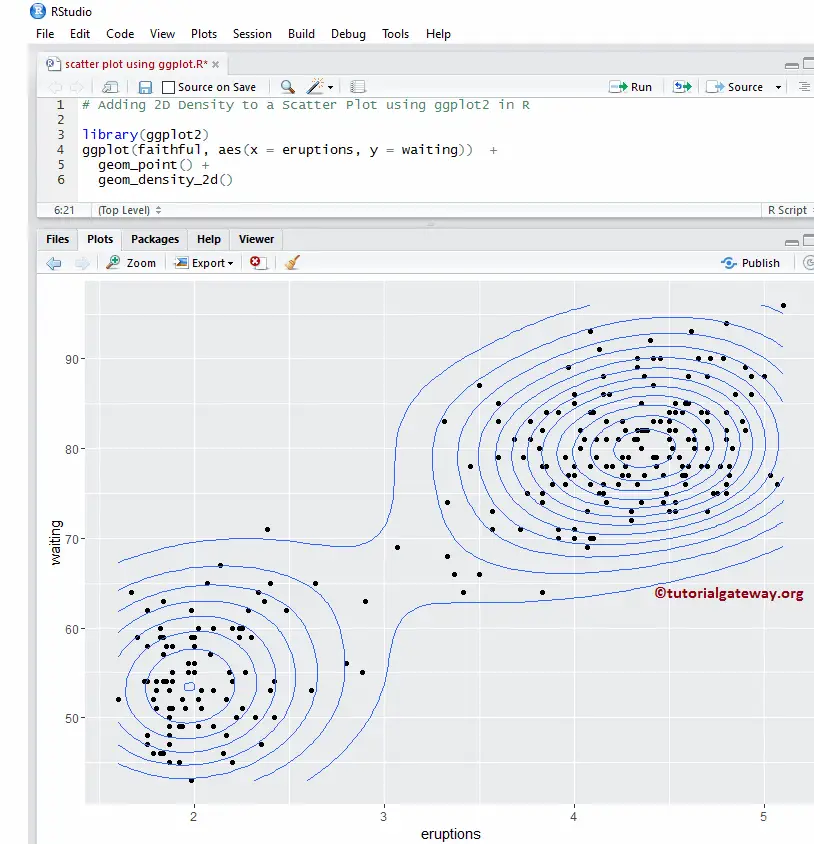
When you use ggplot2, you need to use variables that are contained within a dataframe. The data parameter tells ggplot2 the name of the dataframe that you want to visualize. However, the other parameters and functions you use along with it will dictate exactly what visualization gets created. You’ll use this every time that you want to make any type of data visualization with ggplot2. The ggplot() function is simply the function that we use to initiate a ggplot2 plot. Let’s take a look at each of those separately. There are a few critical pieces to this syntax that you need to know: That tutorial explains most of the basics of the ggplot system.Īt a high level, the syntax for a ggplot2 scatterplot looks something like this: If you’re not familiar with how the ggplot2 system works, you might want to read our introduction to ggplot2 tutorial. The secret to using ggplot2 properly is understanding how the syntax works. Having said all of that, let’s take a look at the syntax for a ggplot scatterplot. If you need to make a scatterplot in R, I strongly recommend that you use ggplot2. Ggplot2 is powerful, flexible, and the syntax is extremely intuitive, once you know how the system works.
#Cran r main name for scatter plot ggplot2 how to#
In fact, once you know how to use it, ggplot2 is arguably one of the best data visualization toolkits on the market, for any programming language. The ggplot2 package is a toolkit for doing data visualization in R, and it’s probably the best toolkit for making charts and graphs in R.

If you’re an R user, you’ve probably heard of ggplot2. If I need to make a scatter plot in R, I always use ggplot2. There’s a better way … ggplot2 scatterplots I haven’t used the plot() function to create a scatterplot in R in almost a decade. The syntax is clumsy, hard to remember, and often inflexible. Like many tools from base R, the plot() function is hard to use and hard to modify beyond making simple modifications. I’m going to be honest: I strongly dislike the base R scatterplot, and I strongly discourage you from using the plot() function. You can create a scatterplot in R using the plot() function. I strongly prefer the ggplot2 scatterplot, but let me quickly talk about both. If you need to create a scatter plot in R, you have at least two major options, which I’ll discuss briefly. For data visualization, reporting, and analytics, you’ll use them over and over. Scatterplots are extremely useful tools for showing the relationship between two numeric variables. Specifically, a scatterplot show the relationship between two numeric variables, where the values of one variable are plotted on the x-axis and the values of the other variable are plotted on the y-axis. Let’s quickly review what a scatterplot is. Everything will make more sense that way. If you need something specific, you can click on any of the following links …īut it’s probably better if you read the whole tutorial. It will explain the syntax for a ggplot scatterplot, and will also show you step-by-step examples. R-release (arm64): plotfunctions_1.4.tgz, r-oldrel (arm64): plotfunctions_1.4.tgz, r-release (x86_64): plotfunctions_1.4.tgz, r-oldrel (x86_64): plotfunctions_1.4.This tutorial will explain how to create a scatter plot in R with ggplot2. R-devel: plotfunctions_1.4.zip, r-release: plotfunctions_1.4.zip, r-oldrel: plotfunctions_1.4.zip Plotfunctions: examples of plot functions in the package the package 'plotfunctions', which contains more general plot functions. the package 'itsadug', which contains the core functions for visualizing and evaluating nonlinear regression models, and 2. Note: Most of the functions were part of the package 'itsadug', which is now split in two packages: 1. As a result, the package does not use formula input or special syntax, but can be used in combination with default R plot functions.
#Cran r main name for scatter plot ggplot2 code#
The package builds further on R graphics by simply combining functions and settings in order to reduce the amount of code to produce for the user.

This package provides a set of simple tools for building plots incrementally, starting with an empty plot region, and adding bars, data points, regression lines, error bars, gradient legends, density distributions in the margins, and even pictures.

When analyzing data, plots are a helpful tool for visualizing data and interpreting statistical models. Plotfunctions: Various Functions to Facilitate Visualization of Data and


 0 kommentar(er)
0 kommentar(er)
